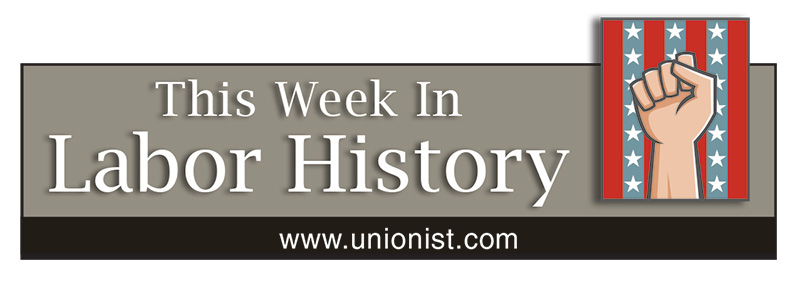This week in labor history: March 29-April 4

MARCH 29
1937 – The U.S. Supreme Court, in West Coast Hotel Co. v. Parrish, upholds the constitutionality of minimum wage legislation enacted by the State of Washington, overturning a decision in 1923 that held that federal minimum wage legislation for women was an unconstitutional infringement of liberty of contract. The case was brought by Elsie Parrish, a hotel housekeeper who lost her job and did not receive back wages in line with the state’s minimum wage for women law.
MARCH 30
1930 – Construction begins on the Hawks Nest Tunnel for a Union Carbide hydroelectric project. 3,000 mostly African-American migrant workers from the South were hired to complete the project and, to save time and money, were not provided with proper safety equipment to work cutting rock that had been discovered to have a high silica content. The official death toll from silicosis was 476, with estimates as high as 700 to 1,000. It is considered to be one of the worst industrial disasters in U.S. history.
MARCH 31
1840 – U.S. President Martin Van Buren issues an Executive Order, “finding that different rules prevail at different places as well in respect to the hours of labor by persons employed on the public works under the immediate authority of himself and the Departments as also in relation to the different classes of workmen, and believing that much inconvenience and dissatisfaction would be removed by adopting a uniform course, hereby directs that all such persons, whether laborers or mechanics, be required to work only the number of hours prescribed by the 10-hour system.”
APRIL 1
1913 – More than 1,000 workers in Hopedale, Mass., employed at the Draper Corporation – which produced automated cotton textile looms – go out on strike over wages and working conditions. Striking workers staged protest marches, rallies, and mass meetings, and were met with concerted and relentless legal action, police violence, and scabs.
APRIL 2
1937 – More than 600 members of the United Chocolate Workers (CIO) union stage a sit-down strike at the Hershey Chocolate Company in Hershey, Pa. On April 7, an anti-union crowd of 3,000 stormed the plant and 25 workers were badly beaten in the ensuring battle. In 1939, the workers affiliated with the Bakery and Confectionary Workers Union (AFL).
2011 – Canadian and American trade unionists rally at the international border between British Columbia and Washington to show their solidarity with public sector workers in Wisconsin facing attacks by that state’s government. The action was organized in conjunction with hundreds of other We Are One rallies that took place throughout North America.
APRIL 3
1968 – Martin Luther King, Jr., returns to Memphis, Tenn., to support striking sanitation workers and delivers his “I’ve Been to the Mountaintop” speech at a church filled with union members and supporters. He was assassinated the next day.
APRIL 4
1907 – The Labor Review begins publication in Minneapolis, Minn., and continues – 106 years later – to chronicle the history of the Labor Movement in the Twin Cities.
1935 – Some 1,600 unemployed men living and working in Canadian federal relief camps – constructing roads and other public works at the rate of 20 cents per day – go on strike. Public support was enormous, and the men decided to take their grievances to the federal government. On June 3, hundreds boarded boxcars headed east in what became known as the “On-to-Ottawa Trek.”
(Compiled by David Prosten, founder of Union Communication Services)


Leave a Reply